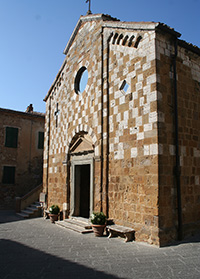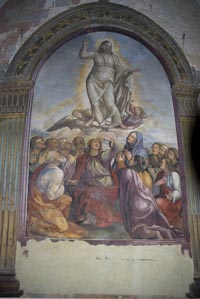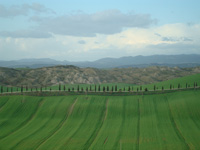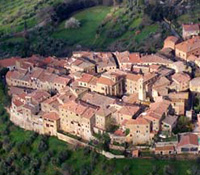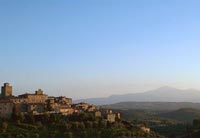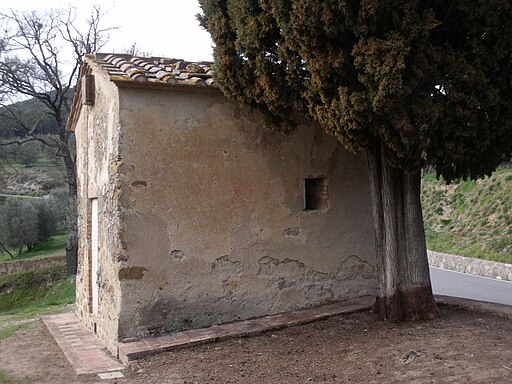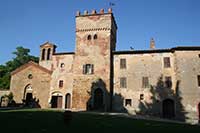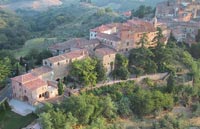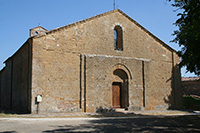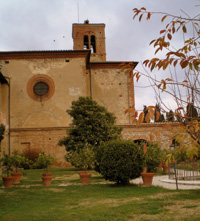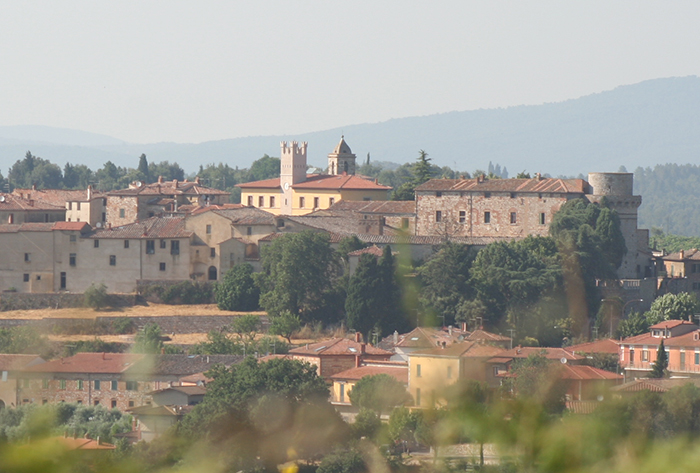 |
|
| Trequanda | |
Trequanda |
| The medieval village of Trequanda developed around the castle dating back to 1200, of which just the cylindric crenellated tower remains, some pieces of the boundary walls and two of the three original entrance doors are still well visible. The thirteenth-century Romanesque Church of St. Peter and Andrew has a façade of white and dark ashlars giving the church a rather unique chromatic effect for this area. In the interior, on the high altar, there is a wonderful polyptych of the Sienese painter Giovanni di Paolo (1479-1549) and here the remains of the Beata Bonizzella Cacciaconti are preserved in a richly decorated urn, a masterpiece of the 16th century Sienese art; on the right wall a beautiful fresco by Sodoma (1479-1549), a fresco by Bartolomeo Mirana, on the left wall there is a niche with a statue representing a Madonna with Infant by Sansovino and a majolica representing the Ascension of the Della Robbia’s school. A good part of the village is still occupied by the ancient Castle of Cacciaconti and by its important annexes, among which a little and unique Italian garden shines. On the north-eastern part there is the majestic cylindric stone tower dominating the whole building, partially rebuilt after the war it points the castle ancient fortified structure. |
||
| Trequanda, a medieval village, was a feud under the rule of the Cacciaconti della Scialenga from 1100 to 1300. Later, because of controversies between them and the local population, the village went under the rule of the Republic of Siena (1555) and followed its destiny until the last war against the imperial troups. The territory was plundered, the village and the castle partially destroyed. In 1774 Trequanda gained independence. At first its territory included Trequanda, Montisi and Petroio. In 1877 San Giovanni d’Asso conquered Montisi; from then on the territory of Trequanda included only Petroio and Castello (Castelmuzio). The castle built in the XII century was partially destroyed. The territory of Trequanda extends over an area of 64 kmq and is limited by Valdichiana to the east and by the “Crete Senesi” of Valle d’Asso to the west. The environment is characterized by the Tuscan hills and is mostly covered by oak and ilex trees; the typical fauna includes pheasants, hares, wild boars, foxes, badgers, roe-deers, follow-deers etc. The climate, thanks to the geographic position of these surroundings, to their altitude and to the wide wooded areas, is mild and pleasant in every season. Agriculture gives important typical products: olive oil, wine, pecorino cheese (sheep cheese), salt pork, honey and other fruits of the hive. The most important place in Trequanda is the square, where there are most of the shops: the newsagent’s, the pharmacy, the post office, the bank, the bar, the Town Hall. There are also other shops, such as the grocer’s, the butcher’s, the baker’s, a restaurant but they are in other streets. Seven streets branch off the square, among which two lead to the town gates: Porta a Sole and Porta a Leccio. Among the remaining five streets, four are linked to each other, the last one leads out of the town wall. In Trequanda there are three churches; the main one is romanic in style and is dedicated to Sant’Andrea; the other ones are the Chiesa dell’Immacolata and the Chiesa della Madonna del Sodo. |
||
Madonna del sodo Castelmuzio |
|
|
| Castelmuzio, is located close to the heart of the UNESCO World Heritage Site, the Val d'Orcia Artistic, Natural and Cultural Park. These coveted designations are protecting this area’s cultural and artistic heritage and its miracle of nature called the "crete senesi", a countryside characterized by undulating ploughed hills and densely forested woods. Castelmuzio is a mesmerizing medieval hamlet and precious treasure of the real Tuscany, and has been wonderfully preserved–you can touch the medieval walls, see the watch tower, and enter the village through the ancient arched stone gate. The cloister Sant Anna in Camprena and the old church Pieve de Santo Stefano in Cennano are situated on opposite sides of the village. Over the years it has been called by several names, Castel Mozzo and later Castello. The local people still refer to it simply as Castello. You can see the old city walls and ramparts, including the embrasures through which cannons were fired. The village came into its own in the 13th century, when many of the buildings you see today were built. Castelmuzio is constructed on a volcanic limestone mount and is defended by walls and ramparts in which the cannon embrasures can still be seen. These are formed of randomly placed limestone and sandstone blocks, as is the Casa Torre in the main square. There are 4 narrows sloping streets, all leading to the square under which lies an ancient travertine based water cistern. In this square, the Piazza della Pieve, the most important buildings are La chiesa Plebana, Casa Torre, Spedale di San Giovanni Battista and la confraternità della SS Trinità and S. Bernardino. The tower, a prominent part of the fortified castle, stood watch over the countryside to protect the citizens from local enemies and barbarians from far away. Later, in the 16th century, it became the village’s civic building and housed the town council meetings and provided residence for the town prior. The tower is part of the Palazzo Fratini, which was once the medieval Spedale di San Giovanni Battista (hospital of St. John the Baptist). The village includes three churches. The most famous is the Pieve di Santo Stefano in Cennano, just outside the village. This small parish church has a documented history since 715 A.D. Its location was originally an Etruscan place of worship, and much later the church was built over an early Roman temple. The part you see today was built in 1285 A.D. From the original base, divided into a nave and two aisles, all that remains are three apses, while today the interior is one single nave. In recent years a cemetery and Roman bath have been discovered very close to the church. During the 15th century the Confraternità della Santissima Trinità opened a hostel for pilgrims. These pilgrims came from France and other parts of Europe, usually on foot, to see the pope in Rome, and followed a route called the Via Francigena. Do visit the Sacred Art Museum which is housed inside. The marvellous Romanesque parish church Pieve of Santo Stefano in Cennano stands next to Castelmuzio. Already mentioned in a Lombard document in 715, it was restored in Romanesque style. Castelmuzio, an ancient village dating back to the time of the Etruscans, is built on a volcanic limestone hilltop overlooking an amazing landscape. |
||
| Petroio |
||
| The church of San Giorgio is at Petroio, close to Trequanda. Petroio (13th century) is built on a curious circular plan and is one of the best brick castles in the region. The picturesque cone-like village perched on a hill, which spirals around a single narrow road within the remains of the ancient walls, the old houses, palaces and churches and the steps that lead up to the summit of the lower and the fort, preserves the warm blonde colour of the sandstone with which almost all of it is built. Its origins are etruscan as the name testifies, deriving from the etruscan Petruni, (or even from the Latin “Praetorium”, and archaeological remains discovered nearby. The church of San Giorgio is the oldest sacred building in the town. Its construction was begun in the year 300. The original structure was lower, as can be ascertained from the façade. There is a visible difference between the type of stone used in the upper and lower parts. A large round window is above the impressive main doorway. The bell tower, which was added in the eighteenth century is on the right side of the church. The interior consists of a single nave and a chapel dedicated to the Santissimo Sacramento along the left wall.
|
||
Petroio (13th century) is built on a curious circular plan
|
||
| Badia di Santa Maria in Sicille |
||
| A few kilometres to the northeast of Trequanda is the Abbadia a Sicille, a beautiful Italian old village. The history of the village dates back to approx 1.200 AD. Abbadia Sicille and Abbadia a Cignano, ancient Templar rest stops on the way to Rome. The name derives from the Etruscan name Segnes, and through the Latin Secennius became Sicille. The presence of the two crosses of Malta to the sides of the portal of the Chiesa di Santa Maria a Sicille suggests the foundation of the complex by the Knights of Malta. Pro Loco Trequanda | Badia di S. Maria a Sicille |
||
Montisi
|
||
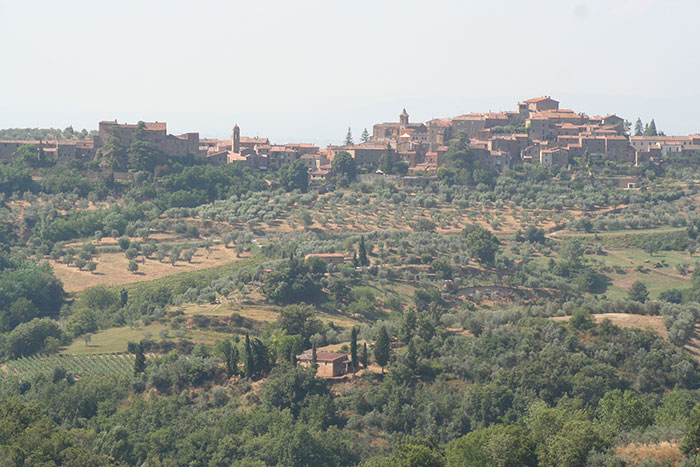 |
||
Montisi
|
||
| Montisi, a frazioni of San Giovanni d'Asso, is a small ridgetop village north of Castelmuzio, located on an Etruscan road that linked the Maremma coastline with the rich city of Arezzo. Montisi is perched on a crag and built around the castle that forms the nucleus of the village. The name is a modernization of Monti Isi, or the Mount of Isis, reflecting the fact that an 8th century B.C. temple of Isis was located a couple of kilometres from Montisi. As you walk around Montisi, you will note that like Siena, it is divided into quarters – the famous contrade. At the edge of the village is the fortified Grancia. The Piccola Accademia di Montisi, located in Montisi, has been founded to provide a center of inspiration for musicians worldwide who have an interest in the harpsichord, its repertoire and its history. Although there are small vineyards all around Montisi there is no definitive local wine. There are three kinds of local wines: red, made principally from the Sangiovese grape and recently awarded its own DOC under the name of Orcia, a local peasant wine which is made with a component of about 20 percent white grapes, and the vin santo, a dessert wine that can range from dry to sweet. [Strada del Vino Orcia] Grancia is a fortified farm complex dating from the 14th century, built on the edge of Montisi, around a courtyard that stored provisions for the Spedale of Santa Maria della Scala in Siena. This extraordinary organisation took care of the flood of pilgrims to Rome that travelled the Via Francigena from the 12th century onwards, and was always in need of supplies. |
||
| Cennano |
||
| The Pieve San Stefano in Cennano, of paleo-Christian origin, arose around the center of what was a Roman settlement, a "vicus". It was situated in an uncivilized area, a part of the greater municipality of Roman Arezzo. It was built on the foundations of a former pagan temple. It is sited along an Etruscan-Roman road leading from Chiusi towards Chianti and Fiesole. The structure already existed in the 4th century, (perhaps consecrated by Saint Donato, second Bishop of Arezzo, who was an evangelizer in this area) as a "baptismal church" when civilized laws advanced into this rural district of plebians. But it was documented for the first time in a decree of Luitprando in 715, which is preserved in the archives of the church in Arezzo. As part of a group of 19 Pievi, it was the object of a famous dispute between the Bishops of Siena and Arezzo, over the question of to whom they belonged, which went on until 1220. Of the 19 ancient baptismal churches, Cennano and Corsignano are the only ones which have retained any integrity, while the others either no longer exist or have been radically altered. From the point of view of history, the Pieve was very important starting from the 7th and 8th centuries till the end of the 14th century, when it was under the same the ecclesiastical and civil jurisdiction as Chiese di S. Flora in Montisi, S. Pietro in Petroio, S. Guisto in Castelmuzio and the Monastery of the Pilgrim in Passeno, near Castelmuzio. This monastery had been founded in the 7th century (653-661) by a Longobardian lord named "Ursus Ariman", and was located close to an alternate route of the Roman via Francigena. The 16th century marked the beginning of its decline; Castelmuzio was growing as its castle was fortified, and the Church of Santa Maria took over those functions which had remained at the Pieve. The church(s) kept on performing (some) ecclesiastical functions in the immediate area until 1723. In September, the Festa della Pieve di Cennano is celebrated. |
|
|
East of Trequanda you reach Sinalunga, a modern, thriving centre with connections to Siena, Arezzo and Chiusi. It has one notabIe painting, an anunciation by Benvenuto di Giovanni, in the church of San Francesco.
|
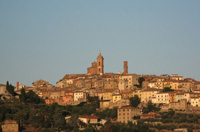 |
|
| Victory of the Sienese Troops at Val di Chiana in 1363 c. 1364 Fresco Palazzo Pubblico, Siena Accompanying Simone Martini's Maestà in the Sala del Mappamondo (formerly known as Sala del Consiglio) were a number of secular images. Frescoes commemorated battles and important military captains. One of the best surviving examples of this reportorial art was commissioned from the painter and miniaturist Lippo Vanni to record the Sienese victory in the Val di Chiana over English mercenaries in 1363. His monochromatic fresco records the progress of the battle and the disposition of the troops episodically across the wall; it is a graphic chronicle of the event rather than a naturalistic reconstruction, with cities carefully labeled and the armies identified by the heraldic flags of their leaders. |
||
Trekking in the Val d'Orcia and the crete Senesi
|
||||
|
|
||||
 |
 |
 |
||
Crete Senesi (laghi tra Castello Leonina e Vescona, Crete Senesi, Asciano)
|
San Giovanni d'Asso
|
Pieve di Santo Stefano a Cennano. Absidi
|
||
 |
 |
|||
Monastero di Sant'Anna in Camprena
|
Abbazia di Monte Oliveto Maggiore
|
Monte Oliveto Maggiore, Campanile
|
||
View Crete Senesi in a larger map
|
|||
| Walking in Tuscany | From Castelmuzio to Pienza
|
|||
Solitary cypresses or lining in long rows ancient country roads, vineyeards which follow the ups and downs of rolling hills, streams overshadowed by trembling poplars, oaks and holm-oaks woods, strawberry trees and brooms growing on the banks of the roads, they make up the landscape which can be enjoyed on approaching Castelmuzio, the old, suggestive medieval village in the heart of Tuscany. When you reach the SS146 to Pienza, you can follow the next walk (Walking around Pienza, marked blue) In both directions you finally reach Pienza. |
|||
| Walking around Pienza |
|||
The walk takes off at Piazza Dante Alighieri, through the Viale S. Caterina, direction Pieve di Corsignano.
|
|||
Montisi - Castelmuzio |
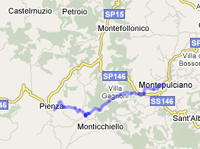 |
||
The itinerary is along old tracks, tarred in parts, otherwise gravel and grass. |
|||
|
|||
Maps: Multigraphic Val d'Orcia, Kompass nr. 662 Lago trasimeno and Kompass nr. 653 Pienza-Montalcino-Monte Amiata.
|
|||
| Located on the outskirts of Castiglioncello Bandini, Podere Santa Pia offers the quiet tranquility of a private retreat, with numerous attractions and gorgeous small hillside villages, beautiful beaches and nature reserves only a short drive away. One of the best places to slow travel in Tuscany is the Val d’Orcia, with its exquisite art, museums and churches in small hillside villages, its cuisine and epic countryside. We suggest a panoramic tour of the valley, so that the trip becomes a unique experience among the colors and atmospheres of this unique Tuscan landscape. Explore the medieval hillside villages in the Val d'Orcia and the crete senesi on your way to Siena, try some Vino Nobile wines in Montepulciano, where the refined beauty of the squares and churches blends perfectly with the ancient traditions of its white wines. Hidden secrets in Tuscany | Holiday home Podere Santa Pia
|
|||
|
|||
 |
|||
Podere Santa Pia is a peaceful retreat, perfect for relaxing with a magnificent panoramic view of the Mediterranean Sea up to the islands of Montecristo and Corsica |
|||

